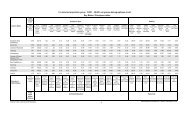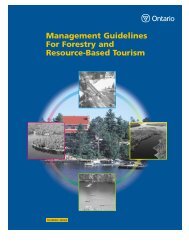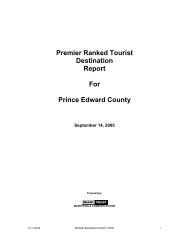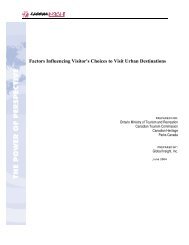Heritage Resources in the Land Use Planning Process - Ministry of ...
Heritage Resources in the Land Use Planning Process - Ministry of ...
Heritage Resources in the Land Use Planning Process - Ministry of ...
- No tags were found...
Create successful ePaper yourself
Turn your PDF publications into a flip-book with our unique Google optimized e-Paper software.
HERITAGE RESOURCES IN THELAND USE PLANNING PROCESSCultural <strong>Heritage</strong> and Archaeology Policies <strong>of</strong> <strong>the</strong>Ontario Prov<strong>in</strong>cial Policy Statement, 2005
AcknowledgementsThe M<strong>in</strong>istry <strong>of</strong> Culture would like to thank Su Murdoch <strong>of</strong> Su Murdoch Historical Consult<strong>in</strong>gand Brandi Clement <strong>of</strong> Jones Consult<strong>in</strong>g Group Ltd. for <strong>the</strong>re valuable contributions to <strong>the</strong>development <strong>of</strong> <strong>the</strong>se heritage <strong>in</strong>formation sheets.Special thanks also goes to <strong>the</strong> follow<strong>in</strong>g organizations and <strong>in</strong>dividuals for <strong>the</strong>ir thoughtful commentsand contributions: M<strong>in</strong>istry <strong>of</strong> Municipal Affairs and Hous<strong>in</strong>g, M<strong>in</strong>istry <strong>of</strong> Environment,M<strong>in</strong>istry <strong>of</strong> Agriculture, Food and Rural Affairs, M<strong>in</strong>istry <strong>of</strong> Public Infrastructure and Renewal,<strong>the</strong> Town <strong>of</strong> Caledon, <strong>the</strong> City <strong>of</strong> Hamilton, <strong>the</strong> Town <strong>of</strong> Markham, <strong>the</strong> City <strong>of</strong> Mississauga, <strong>the</strong>City <strong>of</strong> Ottawa, <strong>the</strong> City <strong>of</strong> Peterborough, <strong>the</strong> City <strong>of</strong> Toronto, Community <strong>Heritage</strong> Ontario,Architectural Conservancy <strong>of</strong> Ontario, Friends <strong>of</strong> Fort York, Jones Consult<strong>in</strong>g Group Ltd. plann<strong>in</strong>gstaff, Marilyn Miller, Kyle MacIntyre, Ken Petersen, Erick Boyd, Mat<strong>the</strong>w Ferguson, Bruce Curtis,Therisa S<strong>in</strong>gh, Ka<strong>the</strong>r<strong>in</strong>e Mills, Hea<strong>the</strong>r Watt, Carol<strong>in</strong>e Cosco, Donna Mundie, Sally Drummond,David Cum<strong>in</strong>g, Joseph Mueller, Regan Hutcheson, George Duncan, Stuart Lazear, Mark Warrack,Erik Hanson, Ca<strong>the</strong>r<strong>in</strong>e Nasmith, Sean Fraser, Dena Doroszenko, Beth Hanna, Dana Hall.The Government <strong>of</strong> Ontario gratefully acknowledges <strong>the</strong> Government <strong>of</strong> Canada's contributionto this publication.Cover photos: M<strong>in</strong>istry <strong>of</strong> CultureISBN 1-4249-0043-3 (Pr<strong>in</strong>t) ISBN 1-4249-0044-1 (PDF)© Queen’s Pr<strong>in</strong>ter for Ontario, 2006
• InfoSheet •Prov<strong>in</strong>cial Policy Statement (PPS, 2005) Cultural <strong>Heritage</strong> and Archaeology Policies 2.6Information Sheet Series –IntroductionW<strong>in</strong>ter 2006WHAT ARE THE CULTURALHERITAGE AND ARCHAEOLOGYPOLICIES IN THE PROVINCIALPOLICY STATEMENT 2005?2.6.1 Significant built heritageresources and significant culturalheritage landscapes shall beconserved.2.6.2 Development and site alterationshall only be permitted onlands conta<strong>in</strong><strong>in</strong>g archaeologicalresources or areas <strong>of</strong> archaeologicalpotential if <strong>the</strong> significantarchaeological resources havebeen conserved by removal anddocumentation, or by preservationon site. Where significantarchaeological resources mustbe preserved on site, only developmentand site alteration whichma<strong>in</strong>ta<strong>in</strong> <strong>the</strong> heritage <strong>in</strong>tegrity <strong>of</strong><strong>the</strong> site may be permitted.What is <strong>the</strong> Prov<strong>in</strong>cial Policy Statement, 2005 <strong>of</strong> <strong>the</strong> Ontario Plann<strong>in</strong>g Act?The Plann<strong>in</strong>g Act provides <strong>the</strong> legislative framework for land use plann<strong>in</strong>g <strong>in</strong>Ontario. It sets out:• how <strong>the</strong> land use plann<strong>in</strong>g system works• who makes decisions• ways to resolve disputes and seek public <strong>in</strong>put• prov<strong>in</strong>cial and municipal roles <strong>in</strong> plann<strong>in</strong>g adm<strong>in</strong>istrationSection 2 <strong>of</strong> <strong>the</strong> Act identifies matters <strong>of</strong> prov<strong>in</strong>cial <strong>in</strong>terest, which <strong>in</strong>cludes <strong>the</strong>conservation <strong>of</strong> significant features <strong>of</strong> architectural, cultural, historical, archaeologicalor scientific <strong>in</strong>terest.Section 3 <strong>of</strong> <strong>the</strong> Act allows <strong>the</strong> prov<strong>in</strong>ce to issue policy statements on matters <strong>of</strong>prov<strong>in</strong>cial <strong>in</strong>terest. The Prov<strong>in</strong>cial Policy Statement (PPS, 2005) is <strong>the</strong> framework forbroad, <strong>in</strong>tegrated and long term plann<strong>in</strong>g. It provides policy direction to municipalitiesand approval authorities that make decisions on land use plann<strong>in</strong>g matters.A New Prov<strong>in</strong>cial Policy StatementThe PPS, 2005 supports <strong>the</strong> pr<strong>in</strong>ciples <strong>of</strong> strong communities, a clean and healthyenvironment and economic growth for <strong>the</strong> long term <strong>in</strong> Ontario. It applies to allplann<strong>in</strong>g applications, matters or proceed<strong>in</strong>gs commenced on or after March 1, 2005.The Act now requires that all decisions affect<strong>in</strong>g land use plann<strong>in</strong>g matters “shall beconsistent with” <strong>the</strong> PPS, 2005. This is a higher test than <strong>the</strong> former “shall haveregard to.”Introduction page 1
• InfoSheet •Prov<strong>in</strong>cial Policy Statement (PPS, 2005) Cultural <strong>Heritage</strong> and Archaeology Policies 2.62.6.3 Development and sitealteration may be permitted onadjacent lands to protectedheritage property where <strong>the</strong>proposed development and sitealteration has been evaluatedand it has been demonstratedthat <strong>the</strong> heritage attributes <strong>of</strong> <strong>the</strong>protected heritage property willbe conserved.Mitigative measures and/or alternativedevelopment approachesmay be required <strong>in</strong> order to conserve<strong>the</strong> heritage attributes <strong>of</strong><strong>the</strong> protected heritage propertyaffected by <strong>the</strong> adjacent developmentor site alteration.In addition to <strong>the</strong> new “shall be consistent with” implementation standard, highlights<strong>of</strong> <strong>the</strong> PPS, 2005 <strong>in</strong>clude:• new policy sections for Employment Areas, Public Spaces, Parks and Open Space,Air Quality and Energy that provide strong, clear direction on key issues that affectour communities• enhanced policies which provide stronger protection for Ontario’s natural and culturalheritage resources• def<strong>in</strong>itions <strong>of</strong> several new and revised terms for clearer guidance (terms italicized<strong>in</strong> <strong>the</strong>se Information Sheets are def<strong>in</strong>ed <strong>in</strong> <strong>the</strong> PPS, 2005)Protect<strong>in</strong>g cultural heritage and archaeological resourcesPPS, 2005 Section 2.0: Wise <strong>Use</strong> and Management <strong>of</strong> <strong>Resources</strong> recognizes thatOntario’s long-term prosperity, environmental health, and social well-be<strong>in</strong>g dependon protect<strong>in</strong>g natural heritage, water, agricultural, m<strong>in</strong>eral, and cultural heritage andarchaeological resources for <strong>the</strong>ir economic, environmental and social benefits.PPS Section 2.6 sets out cultural heritage and archaeology policies:For more <strong>in</strong>formation on culturalheritage and archaeologicalresources contact:Ontario M<strong>in</strong>istry <strong>of</strong> Culture400 University Avenue, 4 th FloorToronto, ON M7A 2R9General_Info@mcl.gov.on.ca(416) 212-06441 (866) 454-0049web page:http://www.culture.gov.on.caAdditional <strong>in</strong>formation on <strong>the</strong>Prov<strong>in</strong>cial Policy Statement,2005 is available on <strong>the</strong> M<strong>in</strong>istry<strong>of</strong> Municipal Affairs andHous<strong>in</strong>g web page:http://www.mah.gov.on.caPolicy 2.6.1 Built heritage resources and cultural heritage landscapesPolicy 2.6.2 Archaeological resources and areas <strong>of</strong> archaeological potentialPolicy 2.6.3 Adjacent lands and protected heritage propertyThe PPS, 2005, toge<strong>the</strong>r with <strong>the</strong> provisions <strong>of</strong> <strong>the</strong> Ontario <strong>Heritage</strong> Act and its regulations,streng<strong>the</strong>ns <strong>the</strong> framework for <strong>the</strong> identification and protection <strong>of</strong> Ontario’scultural heritage and archaeological resources.The M<strong>in</strong>istry <strong>of</strong> Culture <strong>in</strong>formation sheet series is support material for PPS, 2005,and is <strong>in</strong>tended to provide guidance and <strong>in</strong>formation regard<strong>in</strong>g cultural heritage andarchaeological resource conservation <strong>in</strong> land use plann<strong>in</strong>g. The series <strong>in</strong>cludes:IntroductionInfo Sheet #1: Built <strong>Heritage</strong> <strong>Resources</strong>Info Sheet #2: Cultural <strong>Heritage</strong> <strong>Land</strong>scapesInfo Sheet #3: Archaeological <strong>Resources</strong> and Areas <strong>of</strong> Archaeological PotentialInfo Sheet #4: Adjacent <strong>Land</strong>s and Protected <strong>Heritage</strong> PropertyInfo Sheet #5: <strong>Heritage</strong> Impact Assessments and Conservation Plans*Note: This InfoSheet was developed to assist participants <strong>in</strong> <strong>the</strong> land use plann<strong>in</strong>g process and to understand <strong>the</strong> PPS,2005 policies related to <strong>the</strong> conservation plann<strong>in</strong>g <strong>of</strong> cultural heritage and archaeological resources. The <strong>in</strong>formation <strong>in</strong><strong>the</strong> InfoSheet should not be relied upon as a substitute for specialized legal or pr<strong>of</strong>essional advice <strong>in</strong> connection withany particular matter.Header Photos: M<strong>in</strong>istry <strong>of</strong> CultureIntroduction page 2
• InfoSheet •Prov<strong>in</strong>cial Policy Statement (PPS, 2005) Cultural <strong>Heritage</strong> and Archaeology Policies 2.6InfoSheet #1Built <strong>Heritage</strong> <strong>Resources</strong>W<strong>in</strong>ter 2006WHAT IS THE PROVINCIAL POLICYSTATEMENT 2005 FOR THECONSERVATION OF SIGNIFICANTBUILT HERITAGE RESOURCES?2.6.1 Significant built heritageresources and significant culturalheritage landscapes shall beconserved.A policy for <strong>the</strong> conservation <strong>of</strong> significant built heritage resourcesThe Prov<strong>in</strong>cial Policy Statement (PPS, 2005) policy 2.6.1 for <strong>the</strong> conservation <strong>of</strong>significant built heritage resources is not new, but it is streng<strong>the</strong>ned by <strong>the</strong> directionunder Section 3 <strong>of</strong> <strong>the</strong> Plann<strong>in</strong>g Act that land use plann<strong>in</strong>g decisions by municipalitiesand approval authorities “shall be consistent with” <strong>the</strong> PPS, 2005.Municipalities and approval authorities can <strong>in</strong>corporate more detailed built heritageresource conservation objectives and policies reflect<strong>in</strong>g local heritage sites <strong>in</strong>to OfficialPlans, land use plann<strong>in</strong>g documents, and related development approval proceduresor decisions.The PPS, 2005 def<strong>in</strong>es built heritage resources as <strong>in</strong>volv<strong>in</strong>g “one or more significantbuild<strong>in</strong>gs, structures, monuments, <strong>in</strong>stallations or rema<strong>in</strong>s associated witharchitectural, cultural, social, political, economic or military history and identifiedas be<strong>in</strong>g important to a community. These resources may be identified throughdesignation or heritage conservation easement under <strong>the</strong> Ontario <strong>Heritage</strong> Act, orlisted by local, prov<strong>in</strong>cial or federal jurisdictions.”Identify<strong>in</strong>g built heritage resourcesBuilt heritage resources are identified through:• Historical ResearchConsult<strong>in</strong>g maps, land records, photographs, publications, primary and o<strong>the</strong>r sources;• Site Survey and AnalysisW<strong>in</strong>dshield surveys, <strong>in</strong>tensive surveys, site surveys and analysis;• EvaluationApply<strong>in</strong>g criteria for evaluat<strong>in</strong>g design, history and context.InfoSheet #1 page 1
• InfoSheet •Prov<strong>in</strong>cial Policy Statement (PPS, 2005)BUILT HERITAGE RESOURCESEXAMPLES CAN INCLUDE, BUTARE NOT LIMITED TO:Residential, commercial, <strong>in</strong>stitutional,or <strong>in</strong>dustrial build<strong>in</strong>gsAn <strong>in</strong>ventory or mapp<strong>in</strong>g <strong>of</strong> properties that conta<strong>in</strong> significant built heritage resources,can be compiled by local, prov<strong>in</strong>cial, or federal jurisdictions. Some <strong>of</strong> <strong>the</strong>se propertiesmay become a protected heritage property under <strong>the</strong> Ontario <strong>Heritage</strong> Act.A municipal heritage committee can be appo<strong>in</strong>ted under <strong>the</strong> Ontario <strong>Heritage</strong> Actby a municipal Council to identify cultural heritage resources, <strong>in</strong>clud<strong>in</strong>g built heritageresources, and can advise Council on heritage conservation matters. For more <strong>in</strong>formationon identify<strong>in</strong>g built heritage resources, see <strong>the</strong> “<strong>Heritage</strong> Property Evaluation:A Guide to Identify<strong>in</strong>g, Research<strong>in</strong>g and Evaluat<strong>in</strong>g Cultural <strong>Heritage</strong> Property <strong>in</strong>Ontario Communities” (M<strong>in</strong>istry <strong>of</strong> Culture).(Nancy Morand)(M<strong>in</strong>istry <strong>of</strong> Culture)(© 2006 Ontario Tourism)Churches or places <strong>of</strong> worshipDef<strong>in</strong><strong>in</strong>g significanceThe PPS, 2005 def<strong>in</strong>es “built heritage resources” and it def<strong>in</strong>es “significant.” For buil<strong>the</strong>ritage resources to be significant or have cultural heritage value or <strong>in</strong>terest, <strong>the</strong>ymust be “valued for <strong>the</strong> important contribution <strong>the</strong>y make to our understand<strong>in</strong>g <strong>of</strong><strong>the</strong> history <strong>of</strong> a place, an event, or a people.”Typically, <strong>the</strong> significance <strong>of</strong> a built heritage resource is identified by evaluation criteriathat def<strong>in</strong>e <strong>the</strong> characteristics that have cultural heritage value or <strong>in</strong>terest to local,prov<strong>in</strong>cial, or federal jurisdictions. Criteria to def<strong>in</strong>e local cultural heritage significanceis prescribed <strong>in</strong> a regulation made pursuant to section 29(1) (a) <strong>of</strong> <strong>the</strong> Ontario<strong>Heritage</strong> Act.For a protected heritage property under <strong>the</strong> Ontario <strong>Heritage</strong> Act, <strong>the</strong> designation bylawand/or heritage conservation easement agreement should state <strong>the</strong> significance <strong>of</strong><strong>the</strong> built heritage resource, and identify its heritage attributes. These are known asstatements <strong>of</strong> cultural heritage value or <strong>in</strong>terest.The PPS, 2005 def<strong>in</strong>es heritage attributes as “<strong>the</strong> pr<strong>in</strong>cipal features, characteristics,context, and appearance that contribute to <strong>the</strong> cultural heritage significance <strong>of</strong> aprotected heritage property.” These attributes should be identified and consideredwhen significance is be<strong>in</strong>g evaluated.(Su Murdoch)InfoSheet #1 page 2
Cultural <strong>Heritage</strong> and Archaeology Policies 2.6Built heritage resourcesThe identification, list<strong>in</strong>g, evaluation and protection <strong>of</strong> built heritage resources is anongo<strong>in</strong>g process. The PPS, 2005 policies and land use plann<strong>in</strong>g processes are applicableto built heritage resources that have significance to <strong>the</strong> jurisdiction. Built heritageresources <strong>in</strong>clude:• a property with a significant built heritage resource listed by local, prov<strong>in</strong>cial or federaljurisdictions us<strong>in</strong>g evaluation criteria;• a protected heritage property, which means:• real property designated under Part IV (<strong>in</strong>dividual property), Part V (heritageconservation districts), or Part VI (archaeology) <strong>of</strong> <strong>the</strong> Ontario <strong>Heritage</strong> Act• a heritage conservation easement property under Parts II or IV <strong>of</strong> <strong>the</strong> Ontario<strong>Heritage</strong> Act• property that is <strong>the</strong> subject <strong>of</strong> a covenant or agreement between <strong>the</strong> owner <strong>of</strong> aproperty and a conservation body or level <strong>of</strong> government, registered on title andexecuted with <strong>the</strong> primary purpose <strong>of</strong> preserv<strong>in</strong>g, conserv<strong>in</strong>g and ma<strong>in</strong>ta<strong>in</strong><strong>in</strong>g acultural heritage feature or resource, or prevent<strong>in</strong>g its destruction, demolition or loss(Municipal jurisdiction(s) or <strong>the</strong> Ontario <strong>Heritage</strong> Trust can also confirm if aproperty is a protected heritage property)• a significant built heritage resource that is newly identified as part <strong>of</strong> a proposalfor development or site alterationMonuments, such as a cenotaph,statue, cairn, or markers(Kurt Schick)Structures, such as a water tower,bridge, fence, or dam(M<strong>in</strong>istry <strong>of</strong> Culture)M<strong>in</strong><strong>in</strong>g headframesWhat is meant by “conserved”?In <strong>the</strong> PPS, 2005, conserved means “<strong>the</strong> identification, protection, use and/ormanagement <strong>of</strong> cultural heritage and archaeological resources <strong>in</strong> such a way that <strong>the</strong>irheritage values, attributes and <strong>in</strong>tegrity are reta<strong>in</strong>ed. This may be addressed througha conservation plan or heritage impact assessment.”The Ontario <strong>Heritage</strong> Act enables municipalities to identify, list and protect propertieswith cultural heritage value or <strong>in</strong>terest. It also gives municipalities and <strong>the</strong>Ontario <strong>Heritage</strong> Trust <strong>the</strong> ability to hold heritage conservation easements on realproperty. The Ontario <strong>Heritage</strong> Trust, an agency <strong>of</strong> <strong>the</strong> M<strong>in</strong>istry <strong>of</strong> Culture, is dedicatedto identify<strong>in</strong>g, preserv<strong>in</strong>g, protect<strong>in</strong>g and promot<strong>in</strong>g Ontario’s rich and variedheritage resources.(City <strong>of</strong> Timm<strong>in</strong>s)Gravestones or cemetery markers(M<strong>in</strong>istry <strong>of</strong> Culture)InfoSheet #1 page 3
• InfoSheet •Prov<strong>in</strong>cial Policy Statement (PPS, 2005) Cultural <strong>Heritage</strong> and Archaeology Policies 2.6Interior features such as fireplaces,woodworks, or plaster worksConserv<strong>in</strong>g built heritage resources <strong>in</strong> land use plann<strong>in</strong>gThe Plann<strong>in</strong>g Act allows municipalities and approval authorities to adopt OfficialPlan objectives and cultural heritage conservation policies and approval procedures.These can <strong>in</strong>clude, but are not limited to:Demolition control by-lawsInterim control bylawsSubdivision development agreementsF<strong>in</strong>ancial <strong>in</strong>centives such as Community Improvement Plans(Su Murdoch)Ontario <strong>Heritage</strong> Act provisions to be considered <strong>in</strong>clude:Architectural design guidel<strong>in</strong>es<strong>Heritage</strong> property list<strong>in</strong>g and designation provisions<strong>Heritage</strong> conservation easementsRecognition / role <strong>of</strong> municipal heritage committeeGrants and loans for heritage conservationIn light <strong>of</strong> <strong>the</strong> above plann<strong>in</strong>g tools, municipalities and/or plann<strong>in</strong>g approval authorities,through <strong>the</strong>ir Official Plan and o<strong>the</strong>r plann<strong>in</strong>g policy documents, can identify,protect, use and/or manage significant built heritage resources with<strong>in</strong> its jurisdiction.For more <strong>in</strong>formation on buil<strong>the</strong>ritage resources contact:Ontario M<strong>in</strong>istry <strong>of</strong> Culture400 University Avenue, 4 th FloorToronto, ON M7A 2R9General_Info@mcl.gov.on.ca(416) 212-06441 (866) 454-0049web page:http://www.culture.gov.on.caAdditional <strong>in</strong>formation on <strong>the</strong>Prov<strong>in</strong>cial Policy Statement,2005 is available on <strong>the</strong> M<strong>in</strong>istry<strong>of</strong> Municipal Affairs andHous<strong>in</strong>g web page:http://www.mah.gov.on.caTo conserve a significant built heritage resource, a municipality or approval authoritymay require a heritage impact assessment (or equivalent study) to evaluate proposeddevelopment or site alteration to demonstrate that a significant built heritage resourcewill be conserved. Mitigative (avoidance) measures or alternative development or sitealteration approaches may be required.A conservation plan (or equivalent study) may be required as a long term strategyfor conserv<strong>in</strong>g <strong>the</strong> significant built heritage resource. (See InfoSheet #5 on heritageimpact assessments and conservation plans.)*Note: This InfoSheet was developed to assist participants <strong>in</strong> <strong>the</strong> land use plann<strong>in</strong>g process and to understand <strong>the</strong> PPS,2005 policies related to <strong>the</strong> conservation plann<strong>in</strong>g <strong>of</strong> cultural heritage and archaeological resources. The <strong>in</strong>formation <strong>in</strong><strong>the</strong> InfoSheet should not be relied upon as a substitute for specialized legal or pr<strong>of</strong>essional advice <strong>in</strong> connection withany particular matter.Header Photos: M<strong>in</strong>istry <strong>of</strong> CultureInfoSheet #1 page 4
• InfoSheet •Prov<strong>in</strong>cial Policy Statement (PPS, 2005) Cultural <strong>Heritage</strong> and Archaeology Policies 2.6InfoSheet #2Cultural <strong>Heritage</strong> <strong>Land</strong>scapesW<strong>in</strong>ter 2006WHAT IS THE PROVINCIAL POLICYSTATEMENT 2005 DIRECTIONFOR THE CONSERVATION OFSIGNIFICANT CULTURAL HERITAGELANDSCAPES?2.6.1 Significant built heritageresources and significant culturalheritage landscapes shall beconserved.A policy for <strong>the</strong> conservation <strong>of</strong> significant cultural heritage landscapesThe Prov<strong>in</strong>cial Policy Statement (PPS, 2005) policy 2.6.1 for <strong>the</strong> conservation <strong>of</strong>significant cultural heritage landscapes is not new, but it is streng<strong>the</strong>ned by <strong>the</strong> directionunder Section 3 <strong>of</strong> <strong>the</strong> Plann<strong>in</strong>g Act that land use plann<strong>in</strong>g decisions by municipalitiesand approval authorities “shall be consistent with” <strong>the</strong> PPS, 2005.Municipalities and approval authorities can <strong>in</strong>corporate more detailed cultural heritagelandscape conservation objectives and policies reflect<strong>in</strong>g local heritage places, landscapesand districts <strong>in</strong>to Official Plans, land use plann<strong>in</strong>g documents, and related developmentapproval procedures or decisions.The PPS, 2005 expands <strong>the</strong> def<strong>in</strong>ition <strong>of</strong> cultural heritage landscape as “a def<strong>in</strong>edgeographical area <strong>of</strong> heritage significance which has been modified by human activitiesand is valued by a community. A landscape <strong>in</strong>volves a group<strong>in</strong>g(s) <strong>of</strong> <strong>in</strong>dividual heritagefeatures such as structures, spaces, archaeological sites and natural elements, whichtoge<strong>the</strong>r form a significant type <strong>of</strong> heritage form, dist<strong>in</strong>ctive from that <strong>of</strong> its constituentelements or parts. Examples may <strong>in</strong>clude, but are not limited to, heritage conservationdistricts designated under <strong>the</strong> Ontario <strong>Heritage</strong> Act; and villages, parks, gardens,battlefields, ma<strong>in</strong>streets and neighbourhoods, cemeteries, trailways and <strong>in</strong>dustrialcomplexes <strong>of</strong> cultural heritage value.”Types <strong>of</strong> cultural heritage landscapesThere are generally three ma<strong>in</strong> types <strong>of</strong> cultural heritage landscapes. The follow<strong>in</strong>g aretaken from <strong>the</strong> Operational Guidel<strong>in</strong>es adopted by <strong>the</strong> United Nations Educational,Scientific and Cultural Organization (UNESCO) World <strong>Heritage</strong> Committee <strong>in</strong> 1992,and are widely accepted as <strong>the</strong> three primary landscape types:• Designed landscapes: those which have been <strong>in</strong>tentionally designed e.g. a plannedgarden or <strong>in</strong> a more urban sett<strong>in</strong>g, a downtown square.InfoSheet #2 page 1
• InfoSheet •Prov<strong>in</strong>cial Policy Statement (PPS, 2005)A natural feature with culturalassociation, such as specimentrees or plant<strong>in</strong>gs be<strong>in</strong>g part <strong>of</strong> alarger cultural heritage landscape.• Evolved landscapes: those which have evolved through <strong>the</strong> use by people and whoseactivities have directly shaped <strong>the</strong> landscape or area. This can <strong>in</strong>clude a ‘cont<strong>in</strong>u<strong>in</strong>g’landscape where human activities and uses are still on-go<strong>in</strong>g or evolv<strong>in</strong>g e.g. residentialneighbourhood or ma<strong>in</strong>street; or <strong>in</strong> a ‘relict’ landscape, where even thoughan evolutionary process may have come to an end, <strong>the</strong> landscape rema<strong>in</strong>s historicallysignificant e.g. an abandoned m<strong>in</strong>e site or settlement area.• Associative landscapes: those with powerful religious, artistic or cultural associations<strong>of</strong> <strong>the</strong> natural element, as well as with material cultural evidence e.g. a sacred sitewith<strong>in</strong> a natural environment or a historic battlefield.(M<strong>in</strong>istry <strong>of</strong> Culture)Identify<strong>in</strong>g cultural heritage landscapesCultural heritage landscapes are identified through:• Historical ResearchConsult<strong>in</strong>g maps, land records, photographs, publications, primary and o<strong>the</strong>rsources• Site Survey and AnalysisW<strong>in</strong>dshield surveys, <strong>in</strong>tensive surveys, site surveys and analysis <strong>of</strong> <strong>the</strong> various featuresand characteristics which make up <strong>the</strong> cultural heritage landscape as well as del<strong>in</strong>eation<strong>of</strong> landscape boundaries• EvaluationApply<strong>in</strong>g criteria for evaluat<strong>in</strong>g design, history, and context <strong>of</strong> <strong>the</strong> entire subject areaAn <strong>in</strong>ventory or map <strong>of</strong> properties or geographic areas that conta<strong>in</strong> significant culturalheritage landscapes can be compiled by local, prov<strong>in</strong>cial or federal jurisdiction(s).Some <strong>of</strong> <strong>the</strong>se properties and geographic areas may become a protected heritageproperty under <strong>the</strong> Ontario <strong>Heritage</strong> Act.A municipal heritage committee can be appo<strong>in</strong>ted under <strong>the</strong> Ontario <strong>Heritage</strong> Act bya municipal Council to identify heritage resources, <strong>in</strong>clud<strong>in</strong>g both heritage conservationdistricts and cultural heritage landscapes with<strong>in</strong> <strong>the</strong>ir community. For more <strong>in</strong>formationon identify<strong>in</strong>g cultural heritage landscapes, see <strong>the</strong> “<strong>Heritage</strong> Property Evaluation: A Guideto Identify<strong>in</strong>g, Research<strong>in</strong>g and Evaluat<strong>in</strong>g Cultural <strong>Heritage</strong> Property <strong>in</strong> OntarioCommunities” (M<strong>in</strong>istry <strong>of</strong> Culture).Def<strong>in</strong><strong>in</strong>g significanceThe PPS def<strong>in</strong>es “cultural heritage landscapes” and it def<strong>in</strong>es “significant”. For culturalheritage landscapes to be significant, <strong>the</strong>y must be “valued for <strong>the</strong> important contribution<strong>the</strong>y make to our understand<strong>in</strong>g <strong>of</strong> <strong>the</strong> history <strong>of</strong> a place, an event, or a people.”InfoSheet #2 page 2
11/35pág<strong>in</strong>as web durante el último año.Con fecha 22 de agosto de 2013 se <strong>in</strong>corpora al procedimiento, a efectosprobatorios el resultado de la <strong>in</strong>formación obtenida a través de Internet en los siguientessitios web: www.navasjoyeros.com, www.navasjoyeros.es, www.navasjoyeros.org,www.navasjoyeros.eu, www.anillosdecompromisocondiamantes.com,www.joyeriaydiamantes.com.Con fecha 27 de agosto de 2013 la representación de PRIVILEGIA comunicaque el año anterior, junto con otra mercantil, había <strong>in</strong>terpuesto una querella crim<strong>in</strong>alcontra el denunciante que resultó admitida a trámite.Con fecha 30 de agosto se reitera a NAVAS JOYEROS la solicitud de prácticade pruebas en un nuevo domicilio.OCTAVO: Con fechas 29 de agosto de 2013 y 17 de septiembre de 2013 se registrande entrada escritos de PRIVILEGIA y NAVAS JOYEROS remitiendo la documentaciónque les fue solicitada en el trámite de práctica de pruebas, entendiendo que suaportación demuestra la <strong>in</strong>existencia de <strong>in</strong>fracción a lo dispuesto en el artículo 22.2 dela LSSI.NOVENO: Con fecha 3 de octubre de 2013 la Instructora <strong>in</strong>admite la solicitud efectuadapor el denunciante, con registro de entrada del 28 de agosto de 2013, de personarseen el procedimiento sancionador por considerar que éste no había acreditadomediante el escrito registrado de entrada con fecha 6 de septiembre de 2013 ser titularde un derecho o <strong>in</strong>terés legítimo que pudiera resultar afectado por la decisión que seadopte en el expediente, todo ello en virtud de lo dispuesto en el artículo 31.1 de la Ley30/1992, de 26 de noviembre, de Régimen Jurídico de las Adm<strong>in</strong>istraciones Públicas ydel Procedimiento Adm<strong>in</strong>istrativo Común (en adelante LRJAP).DÉCIMO: Con fecha 15 de noviembre de 2013, se configura el navegador de laInstructora para “No permitir que se guarden datos de los sitios” a los efectos decomprobar el funcionamiento de las pág<strong>in</strong>as web www.navasjoyeros.com,www.navasjoyeros.es, www.navasjoyeros.org, www.navasjoyeros.eu ywww.joyeriaydiamantes.com, constando en el expediente Diligencia relativa al resultadoobtenido.Con fecha 18 de noviembre de 2013, configurado el navegador Google Chrome<strong>in</strong>stalado en el equipo de la <strong>in</strong>structora para admitir cookies, y después de haberefectuado la compra de un artículo, se comprueba que elim<strong>in</strong>ando la cookie “frontend”del dom<strong>in</strong>io www.joyeriaydiamantes.com al recargar nuevamente la pág<strong>in</strong>a web encuestión el carrito de la compra se muestra vacío.Con fecha 27 de noviembre de 2013 se <strong>in</strong>corpora al procedimiento documentación sobrela Política de Cookies y Condiciones de Uso de varios de los sitios web de NAVASJOYEROS, cuyo detalle obra en el procedimiento, junto con impresión de losformularios de contacto y/o op<strong>in</strong>ión que figuran en los sitios web de NAVAS JOYEROSy PRIVILEGIA y del Aviso Legal al que éstos redireccionan al clicar el enlace delectura y aceptación de la Política de Privacidad <strong>in</strong>cluido al pie de los mismos .Con fecha 27 de noviembre de 2013 se <strong>in</strong>corporan al procedimiento las capturas depantalla obtenidas a través de Internet en los sitios web www.navasjoyeros.com ywww.joyeriaydiamantes.com al acceder a los mismos.C/ Jorge Juan, 6 www.agpd.es28001 – Madrid sedeagpd.gob.es
• InfoSheet •Prov<strong>in</strong>cial Policy Statement (PPS, 2005)EXAMPLES OF CULTURAL HERITAGELANDSCAPES:A former <strong>in</strong>dustrial site wherema<strong>in</strong> and secondary build<strong>in</strong>gs,technological artifacts, <strong>in</strong>frastructure,transport networks and openspaces are <strong>in</strong> an arrangement thatdepicts <strong>the</strong> work<strong>in</strong>g <strong>of</strong> <strong>the</strong> site.A unique group<strong>in</strong>g <strong>of</strong> a build<strong>in</strong>gand formal garden with<strong>in</strong> a largerheritage conservation district.A riverscape with bridges and trails.(M<strong>in</strong>istry <strong>of</strong> Cuture)A farmscape.(City <strong>of</strong> Waterloo)Def<strong>in</strong><strong>in</strong>g cultural heritage landscape boundariesWith<strong>in</strong> a cultural heritage landscape, <strong>the</strong>re are <strong>of</strong>ten heritage build<strong>in</strong>gs, structures,ru<strong>in</strong>s, trees, plant<strong>in</strong>gs, archaeological resources and o<strong>the</strong>r features or attributes thatcollectively illustrate a historical <strong>the</strong>me or activity. There is usually evidence <strong>of</strong> changeover time, through site evolution and/or natural regeneration. There are also historicand/or visual qualities that can <strong>in</strong>clude viewsheds or site l<strong>in</strong>es from with<strong>in</strong> <strong>the</strong> landscapearea, as well as specific observation po<strong>in</strong>ts from outside its boundaries. Def<strong>in</strong><strong>in</strong>g<strong>the</strong> cultural heritage landscape boundaries can <strong>in</strong>volve a range <strong>of</strong> considerations,<strong>in</strong>clud<strong>in</strong>g but not limited to <strong>the</strong> use <strong>of</strong>: roadways; rights-<strong>of</strong>-way; river corridors;fences; edges <strong>of</strong> tree l<strong>in</strong>es and hedge rows; property l<strong>in</strong>es; landforms; and lakeshores.It is <strong>the</strong>refore important for boundaries <strong>of</strong> a cultural heritage landscape to be clearlydef<strong>in</strong>ed for conservation purposes with<strong>in</strong> a land use plann<strong>in</strong>g context.What is meant by “conserved”?In <strong>the</strong> PPS, 2005 conserved “means <strong>the</strong> identification, protection, use and/ormanagement <strong>of</strong> cultural heritage and archaeological resources <strong>in</strong> such a way that <strong>the</strong>irheritage values, attributes and <strong>in</strong>tegrity are reta<strong>in</strong>ed. This may be addressed througha conservation plan or heritage impact assessment.”The conservation <strong>of</strong> a significant cultural heritage landscape considers not only <strong>the</strong>preservation <strong>of</strong> specific features which make up <strong>the</strong> landscape, but also <strong>the</strong> relationships<strong>of</strong> such features <strong>in</strong>side and outside its boundaries. Consideration should also begiven to <strong>the</strong> surround<strong>in</strong>g context with<strong>in</strong> which a cultural heritage landscape is locatedand <strong>the</strong> need for conservation strategies such as buffer zones.The Ontario <strong>Heritage</strong> Act enables municipalities to identify, list and protect propertieswith cultural heritage value or <strong>in</strong>terest. It also gives municipalities and <strong>the</strong> Ontario<strong>Heritage</strong> Trust <strong>the</strong> ability to hold heritage conservation easements on real property. TheOntario <strong>Heritage</strong> Trust, an agency <strong>of</strong> <strong>the</strong> M<strong>in</strong>istry <strong>of</strong> Culture, is dedicated to identify<strong>in</strong>g,preserv<strong>in</strong>g, protect<strong>in</strong>g and promot<strong>in</strong>g Ontario’s rich and varied heritage resources.O<strong>the</strong>r geographic areas or specialplaces <strong>of</strong> cultural heritage valueor <strong>in</strong>terest such as ma<strong>in</strong> streets.(Su Murdoch)InfoSheet #2 page 4
Cultural <strong>Heritage</strong> and Archaeology Policies 2.6Conserv<strong>in</strong>g cultural heritage landscapes <strong>in</strong> land use plann<strong>in</strong>gThe Plann<strong>in</strong>g Act allows municipalities and approval authorities to adopt OfficialPlan objectives and cultural heritage policies and approval procedures. For <strong>the</strong> conservation<strong>of</strong> significant cultural heritage landscapes, plann<strong>in</strong>g tools <strong>in</strong>clude, but are notlimited to:<strong>Heritage</strong> conservation district policies, guidel<strong>in</strong>es, & studiesArea design guidel<strong>in</strong>esHeight and setback restrictions / site plan control<strong>Land</strong>scape impact assessmentsSecondary plan policies for special areasSpecial zon<strong>in</strong>g by-laws with heritage criteria overlaySubdivision development agreementsCommunity improvement plansStewardshipF<strong>in</strong>ancial <strong>in</strong>centives<strong>Land</strong>scape conservation plansPark area / corridor area management plansIn light <strong>of</strong> <strong>the</strong> above plann<strong>in</strong>g tools, municipalities and/or plann<strong>in</strong>g approval authorities,through <strong>the</strong>ir Official Plan and o<strong>the</strong>r plann<strong>in</strong>g policy documents, can fur<strong>the</strong>r identify,protect and manage significant cultural heritage landscapes with<strong>in</strong> <strong>the</strong>ir jurisdiction.To conserve a significant cultural heritage landscape, a municipality or approvalauthority may require a heritage impact assessment (or equivalent study) to evaluateproposed development or site alteration to demonstrate that a significant culturalheritage landscape will be conserved. Mitigative (avoidance) measures or alternativedevelopment or site alteration approaches may be required.A conservation plan (or equivalent study) may be required as a long term strategy forconserv<strong>in</strong>g <strong>the</strong> significant cultural heritage landscape. (See InfoSheet #5 on heritageimpact assessments and conservation plans.)*Note: This InfoSheet was developed to assist participants <strong>in</strong> <strong>the</strong> land use plann<strong>in</strong>g process and to understand <strong>the</strong> PPS,2005 policies related to <strong>the</strong> conservation plann<strong>in</strong>g <strong>of</strong> cultural heritage and archaeological resources. The <strong>in</strong>formation <strong>in</strong><strong>the</strong> InfoSheet should not be relied upon as a substitute for specialized legal or pr<strong>of</strong>essional advice <strong>in</strong> connection withany particular matter.A cultural heritage landscapemay be scenic and conta<strong>in</strong>notable natural features, but isprimarily important for its significanthistorical associations.(M<strong>in</strong>istry <strong>of</strong> Culture)(M<strong>in</strong>istry <strong>of</strong> Culture)For more <strong>in</strong>formation on culturalheritage landscapes contact:Ontario M<strong>in</strong>istry <strong>of</strong> Culture400 University Avenue, 4 th FloorToronto, ON M7A 2R9General_Info@mcl.gov.on.ca(416) 212-06441 (866) 454-0049web page:http://www.culture.gov.on.caAdditional <strong>in</strong>formation on <strong>the</strong>Prov<strong>in</strong>cial Policy Statement,2005 is available on <strong>the</strong> M<strong>in</strong>istry<strong>of</strong> Municipal Affairs andHous<strong>in</strong>g web page:http://www.mah.gov.on.caInfoSheet #2 page 5Header Photos: M<strong>in</strong>istry <strong>of</strong> Culture
• InfoSheet •Prov<strong>in</strong>cial Policy Statement (PPS, 2005) Cultural <strong>Heritage</strong> and Archaeology Policies 2.6InfoSheet #3Archaeological <strong>Resources</strong> andAreas <strong>of</strong> Archaeological PotentialW<strong>in</strong>ter 2006WHAT IS THE PROVINCIALPOLICY STATEMENT 2005 POLICYFOR THE CONSERVATION OFARCHAEOLOGICAL RESOURCESAND AREAS OF ARCHAEOLOGICALPOTENTIAL?2.6.2 Development and site alterationshall only be permitted onlands conta<strong>in</strong><strong>in</strong>g archaeologicalresources or areas <strong>of</strong> archaeologicalpotential if <strong>the</strong> significantarchaeological resources havebeen conserved by removal anddocumentation, or by preservationon site. Where significantarchaeological resources mustbe preserved on site, only developmentand site alteration whichma<strong>in</strong>ta<strong>in</strong> <strong>the</strong> heritage <strong>in</strong>tegrity <strong>of</strong><strong>the</strong> site may be permitted.A policy for <strong>the</strong> conservation <strong>of</strong> archaeological resources and areas <strong>of</strong>archaeological potentialProv<strong>in</strong>cial Policy Statement (PPS, 2005) 2.6.2 for <strong>the</strong> conservation <strong>of</strong> archaeologicalresources and areas <strong>of</strong> archaeological potential is not new, but it is streng<strong>the</strong>ned bychanges to <strong>the</strong> Plann<strong>in</strong>g Act requir<strong>in</strong>g that plann<strong>in</strong>g decisions by municipalities andapproval authorities “shall be consistent with” prov<strong>in</strong>cial policy statements.Municipalities and approval authorities are to <strong>in</strong>corporate more detailed archaeologicalconservation objectives and policies reflect<strong>in</strong>g local archaeological resources and areas<strong>of</strong> archaeological potential <strong>in</strong>to <strong>the</strong>ir <strong>of</strong>ficial plans, land use plann<strong>in</strong>g documents andrelated development approval processes.The PPS, 2005 def<strong>in</strong>es archaeological resources as <strong>in</strong>clud<strong>in</strong>g “artifacts, archaeologicalsites, and mar<strong>in</strong>e archaeological sites. The identification and evaluation <strong>of</strong> suchresources are based upon archaeological fieldwork undertaken <strong>in</strong> accordance with<strong>the</strong> Ontario <strong>Heritage</strong> Act.”Identify<strong>in</strong>g archaeological resources and areas <strong>of</strong> archaeological potentialThe identification <strong>of</strong> archaeological resources is based on archaeological assessmentby a licensed pr<strong>of</strong>essional archaeologist. Archaeological licens<strong>in</strong>g and report<strong>in</strong>g aregoverned by <strong>the</strong> Ontario <strong>Heritage</strong> Act and its regulations. Licensed archaeologistsmust comply with M<strong>in</strong>istry <strong>of</strong> Culture standards and guidel<strong>in</strong>es when carry<strong>in</strong>g outand report<strong>in</strong>g on archaeological fieldwork. The Ontario <strong>Heritage</strong> Act prohibitsanyone from disturb<strong>in</strong>g an archaeological site without a licence.The M<strong>in</strong>istry <strong>of</strong> Culture ma<strong>in</strong>ta<strong>in</strong>s a database <strong>of</strong> archaeological site locations and aregister <strong>of</strong> archaeological fieldwork reports. A municipality or approval authority mayobta<strong>in</strong> site locations and mapp<strong>in</strong>g for land use plann<strong>in</strong>g purposes, after a data shar<strong>in</strong>gagreement with <strong>the</strong> prov<strong>in</strong>ce is ratified.InfoSheet #3 page 1
Cultural <strong>Heritage</strong> and Archaeology Policies 2.6In <strong>the</strong> PPS, 2005 “conserved” means “<strong>the</strong> identification, protection, use and/ormanagement <strong>of</strong> cultural heritage and archaeological resources <strong>in</strong> such a way that <strong>the</strong>irheritage values, attributes and <strong>in</strong>tegrity are reta<strong>in</strong>ed.”As stated <strong>in</strong> Policy 2.6.2, a significant archaeological resource can be conserved byremoval and documentation, or by preservation on site. Only a licensed pr<strong>of</strong>essionalarchaeologist may remove and document archaeological resources throughcontrolled excavation.(M<strong>in</strong>istry <strong>of</strong> Culture)If preserved on site, only development and site alteration that ma<strong>in</strong>ta<strong>in</strong>s <strong>the</strong> <strong>in</strong>tegrity<strong>of</strong> <strong>the</strong> archaeological resource may be permitted. This may occur, for example, whenan aborig<strong>in</strong>al village site extend<strong>in</strong>g over a large area is preserved by designat<strong>in</strong>g <strong>the</strong>area as green space.A significant archaeological resource can become a protected heritage property under<strong>the</strong> Ontario <strong>Heritage</strong> Act, Parts IV (<strong>in</strong>dividual property), V (heritage conservationdistricts), VI (archaeology), or protected by an archaeological zon<strong>in</strong>g by-law or heritageconservation easement agreement.A licensed pr<strong>of</strong>essional archaeologist can advise a development proponent or approvalauthority on <strong>the</strong> appropriate measures needed to conserve an archaeological resource.Conserv<strong>in</strong>g archaeological resources <strong>in</strong> land use plann<strong>in</strong>gThe conservation <strong>of</strong> significant archaeological resources will <strong>in</strong>volve us<strong>in</strong>g appropriateprotection tools with<strong>in</strong> <strong>the</strong> land use plann<strong>in</strong>g process. A municipality or approvalauthority, through its Official Plan objectives, archaeological conservation policiesand approval procedures, can identify and manage areas <strong>of</strong> archaeological potentialand archaeological resources with<strong>in</strong> its jurisdiction. An archaeological master planconta<strong>in</strong><strong>in</strong>g detailed mapp<strong>in</strong>g <strong>of</strong> all areas <strong>of</strong> archaeological potential is an efficientand effective way <strong>of</strong> ensur<strong>in</strong>g significant archaeological resources are conserved dur<strong>in</strong>gland use plann<strong>in</strong>g and development activities.(Jones Consult<strong>in</strong>g Group Ltd.)Examples <strong>of</strong> significant archaeologicalresources can <strong>in</strong>clude,but are not limited to, aborig<strong>in</strong>alvillages, seasonal camps, spiritualsites and landscapes, lithicscatters, ossuaries, shipwrecks,military site(s), European settlement(s)and o<strong>the</strong>r evidence<strong>of</strong> occupation.(Huronia Museum)InfoSheet #3 page 3(M<strong>in</strong>istry <strong>of</strong> Culture)
• InfoSheet •Prov<strong>in</strong>cial Policy Statement (PPS, 2005) Cultural <strong>Heritage</strong> and Archaeology Policies 2.6WHAT ARE AREAS OFARCHAEOLOGICAL POTENTIAL?Areas <strong>of</strong> archaeological potentialmeans areas with <strong>the</strong> likelihoodto conta<strong>in</strong> archaeologicalresources. Criteria for determ<strong>in</strong><strong>in</strong>garchaeological potential areestablished by <strong>the</strong> Prov<strong>in</strong>ce, butmunicipal approaches whichachieve <strong>the</strong> same objectives mayalso be used. Archaeologicalpotential is confirmed througharchaeological fieldwork undertaken<strong>in</strong> accordance with <strong>the</strong>Ontario <strong>Heritage</strong> Act. (PPS, 2005)Prov<strong>in</strong>cial criteria for determ<strong>in</strong><strong>in</strong>g archaeological potential:Known archaeological sites with<strong>in</strong> 250 metresWater source (primary, secondary, ancient) with<strong>in</strong> 300 metresElevated topography (e.g., knolls, druml<strong>in</strong>s, eskers, plateaux)Pockets <strong>of</strong> sandy soil <strong>in</strong> a clay or rocky areaUnusual land formations (e.g., mounds, caverns, waterfalls)Resource-rich area (concentrations <strong>of</strong> animal, vegetable or m<strong>in</strong>eral resources)Non-aborig<strong>in</strong>al settlement (e.g., monuments, cemeteries)Historic transportation (e.g., road, rail, portage)Property protected under Ontario <strong>Heritage</strong> ActLocal knowledgeRecent disturbance (extensive and <strong>in</strong>tensive)Fur<strong>the</strong>r <strong>in</strong>formation on tools for identify<strong>in</strong>g and manag<strong>in</strong>g archaeological resourceswill be available <strong>in</strong> technical guides and manuals developed by <strong>the</strong> M<strong>in</strong>istry <strong>of</strong> Culture.For more <strong>in</strong>formation onarchaeological resources andareas <strong>of</strong> archaeological potentialcontact:Ontario M<strong>in</strong>istry <strong>of</strong> Culture400 University Avenue, 4 th FloorToronto, ON M7A 2R9General_Info@mcl.gov.on.ca(416) 212-06441 (866) 454-0049web page:http://www.culture.gov.on.caAdditional <strong>in</strong>formation on <strong>the</strong>Prov<strong>in</strong>cial Policy Statement,2005 is available on <strong>the</strong> M<strong>in</strong>istry<strong>of</strong> Municipal Affairs andHous<strong>in</strong>g web page:http://www.mah.gov.on.ca*Note: This Info Sheet was developed to help participants <strong>in</strong> <strong>the</strong> land use plann<strong>in</strong>g process to understand <strong>the</strong> PPS, 2005policies related to <strong>the</strong> conservation <strong>of</strong> cultural heritage and archaeological resources. The <strong>in</strong>formation <strong>in</strong> <strong>the</strong> Info Sheet shouldnot be relied upon as a substitute for specialized legal or pr<strong>of</strong>essional advice <strong>in</strong> connection with any particular matter.Header images: Archaeological site (M<strong>in</strong>istry <strong>of</strong> Culture database), “At Barrie on Lake Simcoe, Upper Canada 1841”, George RussellDartnell (National Archives <strong>of</strong> Canada), Archaeological site (M<strong>in</strong>istry <strong>of</strong> Culture database), “Indian Wigwams, Upper Canada 1832”,Henry Byam Mart<strong>in</strong> (National Archives <strong>of</strong> Canada).InfoSheet #3 page 4
• InfoSheet •Prov<strong>in</strong>cial Policy Statement (PPS, 2005) Cultural <strong>Heritage</strong> and Archaeology Policies 2.6InfoSheet #4Adjacent <strong>Land</strong>s andProtected <strong>Heritage</strong> PropertyW<strong>in</strong>ter 2006WHAT IS THE PROVINCIAL POLICYSTATEMENT, 2005 FOR ADJACENTLANDS AND CONSERVING THEHERITAGE ATTRIBUTES OF APROTECTED HERITAGE PROPERTY?2.6.3 Development and sitealteration may be permitted onadjacent lands to protectedheritage property where <strong>the</strong>proposed development and sitealteration has been evaluatedand it has been demonstratedthat <strong>the</strong> heritage attributes <strong>of</strong> <strong>the</strong>protected heritage property willbe conserved.Mitigative measures and/or alternativedevelopment approachesmay be required <strong>in</strong> order to conserve<strong>the</strong> heritage attributes <strong>of</strong><strong>the</strong> protected heritage propertyaffected by <strong>the</strong> adjacent developmentor site alteration.A policy for development and site alteration on adjacent lands to a protectedheritage propertyThe Prov<strong>in</strong>cial Policy Statement (PPS, 2005) policy 2.6.3 for development and sitealteration on adjacent lands to a protected heritage property is new. The policy providesthat mitigative measures or alternative development approaches may be required toconserve <strong>the</strong> heritage attributes <strong>of</strong> a protected heritage property.Municipalities and approval authorities can now <strong>in</strong>corporate more detailed conservationobjectives and policies reflect<strong>in</strong>g local heritage resources, heritage attributes, and anylimitations on development for lands adjacent to protected heritage property <strong>in</strong>to <strong>the</strong>irOfficial Plans, land use plann<strong>in</strong>g documents, and <strong>the</strong>ir related development approvalprocedures or processes.What is meant by adjacent lands?For purpose <strong>of</strong> policy 2.6.3, <strong>the</strong> PPS, 2005 def<strong>in</strong>es adjacent lands “as those landscontiguous to a protected heritage property or as o<strong>the</strong>rwise def<strong>in</strong>ed <strong>in</strong> <strong>the</strong> municipalOfficial Plan.”The Official Plan can def<strong>in</strong>e <strong>the</strong> extent <strong>of</strong> adjacent lands and distances from developmentareas required to m<strong>in</strong>imize or mitigate or avoid an impact on <strong>the</strong> heritageattributes <strong>of</strong> an Ontario <strong>Heritage</strong> Act designated heritage build<strong>in</strong>g, archaeologicalsite, and/or heritage conservation district. Buffer areas can be def<strong>in</strong>ed based on <strong>the</strong>specific heritage attributes identified for <strong>the</strong> protected heritage property.What is a protected heritage property?The Ontario <strong>Heritage</strong> Act enables municipalities, plann<strong>in</strong>g authorities, and <strong>the</strong>prov<strong>in</strong>ce to identify and protect real property with cultural heritage value or <strong>in</strong>terest.InfoSheet #4 page 1
• InfoSheet •Prov<strong>in</strong>cial Policy Statement (PPS, 2005)HERITAGE ATTRIBUTES EXAMPLES:• A protected heritage house thatis significant for its architecturalstyle. The significance may beembodied <strong>in</strong> <strong>the</strong> physical elementsdesigned <strong>in</strong> a particularstyle. Elements such as facadedetails, w<strong>in</strong>dows, build<strong>in</strong>gheights <strong>in</strong>volv<strong>in</strong>g mass<strong>in</strong>g andorientaton may be all consideredto be <strong>the</strong> heritage attributes.• A designated heritage build<strong>in</strong>gor heritage conservation districtmay conta<strong>in</strong> significant culturalheritage landscape featuressuch as gardens, narrowstreetscape patterns, prom<strong>in</strong>entstructures. These features andviews to and from <strong>the</strong>m cansupport <strong>the</strong> significance <strong>of</strong> <strong>the</strong>property, and may be consideredto be heritage attributes.• An important aspect <strong>of</strong> <strong>the</strong> history<strong>of</strong> a people may be representedby <strong>the</strong> physical layout <strong>of</strong> aprotected heritage propertyconta<strong>in</strong><strong>in</strong>g ru<strong>in</strong>s or an archaeologicalsite.A protected heritage property as def<strong>in</strong>ed <strong>in</strong> <strong>the</strong> PPS, 2005 means:• Real property designated under Part IV (<strong>in</strong>dividual property), Part V(heritageconservation districts), or Part VI (archaeology) <strong>of</strong> <strong>the</strong> Ontario <strong>Heritage</strong> Act;• A heritage conservation easement property under Parts II or IV <strong>of</strong> <strong>the</strong> Ontario<strong>Heritage</strong> Act; and• Property that is <strong>the</strong> subject <strong>of</strong> a covenant or agreement between <strong>the</strong> owner <strong>of</strong> a propertyand a conservation body or level <strong>of</strong> government, registered on title and executedwith <strong>the</strong> primary purpose <strong>of</strong> preserv<strong>in</strong>g, conserv<strong>in</strong>g, and ma<strong>in</strong>ta<strong>in</strong><strong>in</strong>g a cultural heritagefeature or resource, or prevent<strong>in</strong>g its destruction, demolition or loss.What are heritage attributes and how are <strong>the</strong>se identified?The PPS, 2005 def<strong>in</strong>es heritage attributes as “<strong>the</strong> pr<strong>in</strong>cipal features, characteristics,context and appearance that contribute to <strong>the</strong> cultural heritage significance <strong>of</strong> aprotected heritage property.”For a protected heritage property, <strong>the</strong> designation by-law or heritage conservation easementagreement should identify <strong>the</strong> cultural heritage value or <strong>in</strong>terest and describe <strong>the</strong>heritage attributes <strong>of</strong> <strong>the</strong> cultural heritage or archaeological resource. The municipalityshould ensure that heritage attributes <strong>of</strong> a protected heritage property are effectivelyidentified and described <strong>in</strong> <strong>the</strong> designation by-law or heritage conservation easementagreement. The level <strong>of</strong> detail should be sufficient to guide <strong>the</strong> approval, modification,or denial <strong>of</strong> a proposed development or site alteration that affects a protectedheritage property.Designation by-laws and heritage conservation easement agreements that <strong>in</strong>adequatelydescribe significance and <strong>the</strong> heritage attributes <strong>of</strong> a property may need to beimproved. This can be done through historical research, site survey and analysis, andevaluation to clarify <strong>the</strong> <strong>in</strong>tent <strong>of</strong> <strong>the</strong> by-law or easement agreement. The municipalityor Ontario <strong>Heritage</strong> Trust can verify if a property or geographical area is a protectedheritage property.What does it mean to conserve <strong>the</strong> heritage attributes?The PPS, 2005 def<strong>in</strong>es “conserved” as “<strong>the</strong> identification, protection, use and/ormanagement <strong>of</strong> cultural heritage and archaeological resources <strong>in</strong> such a way that <strong>the</strong>irheritage values, attributes and <strong>in</strong>tegrity are reta<strong>in</strong>ed. This may be addressed througha conservation plan or heritage impact assessment.” The term conserved is def<strong>in</strong>ed <strong>in</strong><strong>the</strong> PPS, 2005 because <strong>of</strong> <strong>the</strong> importance <strong>of</strong> early identification, protection andInfoSheet #4 page 2
Cultural <strong>Heritage</strong> and Archaeology Policies 2.6management <strong>of</strong> cultural heritage resources and its heritage attributes dur<strong>in</strong>g <strong>the</strong> landuse and development process.PPS 2005 policy 2.6.3 provides that “mitigative measures and/or alternative developmentapproaches may be required to conserve <strong>the</strong> heritage attributes <strong>of</strong> <strong>the</strong> protectedheritage property affected by <strong>the</strong> adjacent development or site alteration.”To conserve <strong>the</strong> heritage attributes <strong>of</strong> a protected heritage property, a municipality orapproval authority may require a heritage impact assessment to evaluate <strong>the</strong> proposeddevelopment or site alteration on adjacent lands, and to demonstrate that <strong>the</strong> heritageattributes <strong>of</strong> <strong>the</strong> protected heritage property will be conserved. A conservation plan maybe required as a long term strategy for conserv<strong>in</strong>g <strong>the</strong> heritage attributes <strong>of</strong> <strong>the</strong> protectedheritage property.The follow<strong>in</strong>g graphics are sample illustrations <strong>of</strong> evaluations and impact assessmentsfor <strong>the</strong> designated heritage conservation district <strong>of</strong> Fort York <strong>in</strong> Toronto. This district’sheritage attributes <strong>in</strong>clude views to and from <strong>the</strong> Fort. In addition, potential archaeologicalfeatures and sites located on <strong>the</strong> adjacent properties are also considered to beheritage attributes.COMPONENTS OF A HERITAGEIMPACT ASSESSMENT FORTHE EVALUATION OF HERITAGEATTRIBUTES MUST:Address <strong>the</strong> significance andheritage attributes <strong>of</strong> a culturalheritage resource;Identify any impact a proposeddevelopment or site alterationmay have on <strong>the</strong> cultural heritageresources;Evaluate and/or recommend alternativeconservation methods tomitigate <strong>the</strong> impact <strong>of</strong> a proposeddevelopment or site alteration oncultural heritage resources.Below is an example <strong>of</strong> a prov<strong>in</strong>ciallyand nationally significantcultural heritage landscapeevaluated for its context andcharacter. Views from <strong>the</strong> BrockMonument near Niagara-on-<strong>the</strong>-Lake are considered to beheritage attributes.(M<strong>in</strong>istry <strong>of</strong> Culture)(M<strong>in</strong>istry <strong>of</strong> Culture)(Graphics courtesy <strong>of</strong> University <strong>of</strong> Toronto Centre for <strong>Land</strong>scape Research for <strong>the</strong>Friends <strong>of</strong> Fort York)InfoSheet #4 page 3
• InfoSheet •Prov<strong>in</strong>cial Policy Statement (PPS, 2005) Cultural <strong>Heritage</strong> and Archaeology Policies 2.6Conserv<strong>in</strong>g heritage attributes <strong>in</strong> land use plann<strong>in</strong>gMunicipalities and approval authorities can adopt Official Plan policies, objectivesand o<strong>the</strong>r heritage conservation policies and approval procedures for conserv<strong>in</strong>g heritageattributes. An impact on <strong>the</strong> heritage attributes <strong>of</strong> a protected heritage property can bem<strong>in</strong>imized or avoided, for example, by mitigative measures and/or alterative developmentapproaches, buffer zones, zon<strong>in</strong>g, setback, design guidel<strong>in</strong>es, regulation <strong>of</strong> density andheight, and o<strong>the</strong>r site plan control mechanisms.The graphic below is an example <strong>of</strong> a heritage design guidel<strong>in</strong>e image for heritage conservationdistricts. Similar municipal guidel<strong>in</strong>es can be applied for o<strong>the</strong>r protectedheritage sites and areas, as an effective tool for guid<strong>in</strong>g adjacent land developmentproposals early <strong>in</strong> <strong>the</strong> land plann<strong>in</strong>g process. This will allow for mitigative measuresand alternative development approaches to be considered for <strong>the</strong> conservation <strong>of</strong> heritageattributes, such as context and character.For more <strong>in</strong>formation onadjacent lands and protectedheritage property contact:Ontario M<strong>in</strong>istry <strong>of</strong> Culture400 University Avenue, 4 th FloorToronto, ON M7A 2R9General_Info@mcl.gov.on.ca(416) 212-06441 (866) 454-0049web page:http://www.culture.gov.on.caAdditional <strong>in</strong>formation on <strong>the</strong>Prov<strong>in</strong>cial Policy Statement,2005 is available on <strong>the</strong> M<strong>in</strong>istry<strong>of</strong> Municipal Affairs andHous<strong>in</strong>g web page:http://www.mah.gov.on.ca(M<strong>in</strong>istry <strong>of</strong> Culture)*Note: This InfoSheet was developed to assist participants <strong>in</strong> <strong>the</strong> land use plann<strong>in</strong>g process and to understand <strong>the</strong> PPS,2005 policies related to <strong>the</strong> conservation plann<strong>in</strong>g <strong>of</strong> cultural heritage and archaeological resources. The <strong>in</strong>formation <strong>in</strong><strong>the</strong> InfoSheet should not be relied upon as a substitute for specialized legal or pr<strong>of</strong>essional advice <strong>in</strong> connection withany particular matter.Header photos: Dunlop Street East, Barrie (Jones Consult<strong>in</strong>g Group Ltd.), Ottawa (M<strong>in</strong>istry <strong>of</strong> Culture), Toronto (M<strong>in</strong>istry <strong>of</strong> Culture),Hedford Church Cemetery, Richmond Hill (Su Murdoch)InfoSheet #4 page 4
• InfoSheet •Prov<strong>in</strong>cial Policy Statement (PPS, 2005) Cultural <strong>Heritage</strong> and Archaeology Policies 2.6InfoSheet #5<strong>Heritage</strong> Impact Assessmentsand Conservation PlansW<strong>in</strong>ter 2006Preserved Goldie Mill Ru<strong>in</strong>s located<strong>in</strong> <strong>the</strong> City <strong>of</strong> Guelph(Leanne Piper)<strong>Heritage</strong> impact assessments and conservation plans as conditions <strong>of</strong> developmentand site alterationWith regard to cultural heritage and archaeological resources, <strong>the</strong> Prov<strong>in</strong>cial PolicyStatement, 2005 issued under <strong>the</strong> authority <strong>of</strong> <strong>the</strong> Plann<strong>in</strong>g Act def<strong>in</strong>es “conserved”as “<strong>the</strong> identification, protection, use and/or management <strong>of</strong> cultural heritage andarchaeological resources <strong>in</strong> such a way that <strong>the</strong>ir heritage values, attributes and<strong>in</strong>tegrity are reta<strong>in</strong>ed. This may be addressed through a conservation plan or heritageimpact assessment.”To conserve a cultural heritage resource, a municipality or approval authority mayrequire a heritage impact assessment and/or a conservation plan to guide <strong>the</strong> approval,modification, or denial <strong>of</strong> a proposed development or site alteration that affects acultural heritage resource. To ensure implementation <strong>of</strong> a conservation plan, a municipalitymay require an owner to post a letter <strong>of</strong> credit, bond or certified cheque aspart <strong>of</strong> <strong>the</strong> development approval process.This applies to all properties or geographic areas conta<strong>in</strong><strong>in</strong>g cultural heritage resourcesthat are significant or “valued for <strong>the</strong> important contribution <strong>the</strong>y make to our understand<strong>in</strong>g<strong>of</strong> <strong>the</strong> history <strong>of</strong> a place, an event, or a people.” (PPS, 2005). Properties andgeographic areas <strong>in</strong>clude: all listed, <strong>in</strong>ventoried, mapped heritage properties by local,prov<strong>in</strong>cial or federal jurisdiction(s); protected heritage property(s); newly identifiedcultural heritage sites which may need fur<strong>the</strong>r evaluation; and areas that can beidentified as hav<strong>in</strong>g known archaeological sites or archaeological potential.Us<strong>in</strong>g tools such as heritage impact assessments and conservation plans, municipalitiesand approval authorities can fur<strong>the</strong>r enhance <strong>the</strong>ir own heritage preservation objectives.InfoSheet #5 page 1
• InfoSheet •Prov<strong>in</strong>cial Policy Statement (PPS, 2005)PRINCIPLES IN THE CONSERVATIONOF HISTORIC PROPERTIESRespect for DocumentaryEvidenceDo not base restoration onconjecture.Respect for Orig<strong>in</strong>al LocationDo not move build<strong>in</strong>gs unless <strong>the</strong>reis no o<strong>the</strong>r means to save <strong>the</strong>m.Respect for Historic MaterialRepair/conserve ra<strong>the</strong>r thanreplace build<strong>in</strong>g materials andf<strong>in</strong>ishes, except where absolutelynecessary.A heritage impact assessment (or equivalent study) is a study to determ<strong>in</strong>e if any culturalheritage resources (<strong>in</strong>clud<strong>in</strong>g those previously identified and those found as part <strong>of</strong><strong>the</strong> site assessment) or <strong>in</strong> any areas <strong>of</strong> archaeological potential, are impacted by aspecific proposed development or site alteration. It can also demonstrate how <strong>the</strong>cultural heritage resource will be conserved <strong>in</strong> <strong>the</strong> context <strong>of</strong> redevelopment or sitealteration. Mitigative or avoidance measures or alternative development or site alterationapproaches may be recommended. For archaeological assessments, fieldworkmust be undertaken by licensed pr<strong>of</strong>essional archaeologists <strong>in</strong> accordance with <strong>the</strong>Ontario <strong>Heritage</strong> Act and its regulations. (refer to InfoSheet #3 entitled Archaeological<strong>Resources</strong> and Areas <strong>of</strong> Archaeological Potential).A conservation plan (or equivalent study) is a document that details how a culturalheritage resource can be conserved. The conservation plan may be supplemental to aheritage impact assessment, but it is typically a separate document. The recommendations<strong>of</strong> <strong>the</strong> plan should <strong>in</strong>clude descriptions <strong>of</strong> repairs, stabilization and preservationactivities as well as long term conservation, monitor<strong>in</strong>g and ma<strong>in</strong>tenance measures.Respect for Orig<strong>in</strong>al FabricRepair with like materials.Respect for <strong>the</strong> Build<strong>in</strong>g’s HistoryDo not restore to one period at <strong>the</strong>expense <strong>of</strong> ano<strong>the</strong>r period.ReversibilityAlterations should allow a resourceto return to its orig<strong>in</strong>al conditions.LegibilityNew work to be dist<strong>in</strong>guishablefrom old.Ma<strong>in</strong>tenanceWith cont<strong>in</strong>uous care, futurerestoration will not be necessary.What is <strong>the</strong> content <strong>of</strong> a heritage impact assessment?A heritage impact assessment generally conta<strong>in</strong>s, but is not limited to <strong>the</strong> follow<strong>in</strong>g<strong>in</strong>formation:1. Historical Research, Site Analysis and EvaluationIf <strong>the</strong> available identification and description <strong>of</strong> <strong>the</strong> significance and heritage attributes<strong>of</strong> <strong>the</strong> cultural heritage resource are <strong>in</strong>adequate for <strong>the</strong> purposes <strong>of</strong> <strong>the</strong> heritageimpact assessment, or <strong>the</strong> cultural heritage resource is newly identified, research, sitesurvey and analysis, and evaluation are required. An explanation <strong>of</strong> <strong>the</strong> methodologyused must accompany a clear statement <strong>of</strong> <strong>the</strong> conclusions regard<strong>in</strong>g <strong>the</strong> significanceand heritage attributes <strong>of</strong> <strong>the</strong> cultural heritage resource.2. Identification <strong>of</strong> <strong>the</strong> Significance and <strong>Heritage</strong> Attributes <strong>of</strong> <strong>the</strong> Cultural <strong>Heritage</strong>ResourceThis is usually a summary <strong>of</strong> <strong>the</strong> cultural heritage value or <strong>in</strong>terest and <strong>the</strong> heritageattributes conta<strong>in</strong>ed <strong>in</strong> a heritage property municipal designation bylaw, heritageconservation easement agreement, or o<strong>the</strong>r list<strong>in</strong>gs. This summary should clearlyarticulate <strong>the</strong> cultural heritage value or <strong>in</strong>terest and heritage attributes <strong>of</strong> <strong>the</strong> heritageresource. If <strong>the</strong> property is not a protected heritage property but is listed or is newlyidentified and may possess heritage significance, statements <strong>of</strong> cultural heritage valueor <strong>in</strong>terest and <strong>the</strong> heritage attributes should still be developed.InfoSheet #5 page 2
Cultural <strong>Heritage</strong> and Archaeology Policies 2.63. Description <strong>of</strong> <strong>the</strong> Proposed Development or Site AlterationThis description details <strong>the</strong> rationale and purpose for <strong>the</strong> development or site alteration,<strong>the</strong> proposed works and graphical layout, and how <strong>the</strong> development or site alterationfits with <strong>the</strong> objectives <strong>of</strong> <strong>the</strong> municipality or approval authority.4. Measurement <strong>of</strong> Development or Site Alteration ImpactAny impact (direct or <strong>in</strong>direct, physical or aes<strong>the</strong>tic) <strong>of</strong> <strong>the</strong> proposed development orsite alteration on a cultural heritage resource must be identified. The effectiveness <strong>of</strong>any proposed conservation or mitigative or avoidance measures must be evaluated on<strong>the</strong> basis <strong>of</strong> established pr<strong>in</strong>ciples, standards and guidel<strong>in</strong>es for heritage conservation.5. Consideration <strong>of</strong> Alternatives, Mitigation and Conservation MethodsWhere an impact on a cultural heritage resource is identified, and <strong>the</strong> proposedconservation or mitigative measures <strong>in</strong>clud<strong>in</strong>g avoidance, are considered <strong>in</strong>effective,o<strong>the</strong>r conservation or mitigative measures, or alternative development or site alterationapproaches must be recommended.6. Implementation and Monitor<strong>in</strong>gThis is a schedule and report<strong>in</strong>g structure for implement<strong>in</strong>g <strong>the</strong> recommended conservationor mitigative or avoidance measures, and monitor<strong>in</strong>g <strong>the</strong> cultural heritageresource as <strong>the</strong> development or site alteration progresses.7. Summary Statement and Conservation RecommendationsThis is a description <strong>of</strong>:• <strong>the</strong> significance and heritage attributes <strong>of</strong> <strong>the</strong> cultural heritage resource;• <strong>the</strong> identification <strong>of</strong> any impact that <strong>the</strong> proposed development will have on <strong>the</strong>cultural heritage resource;• an explanation <strong>of</strong> what conservation or mitigative measures, or alternative developmentor site alteration approaches are recommended to m<strong>in</strong>imize or avoid any impact on<strong>the</strong> cultural heritage resource;• if applicable, clarification <strong>of</strong> why some conservation or mitigative measures, oralternative development or site alteration approaches are not appropriate.NEGATIVE IMPACTSNegative impact on a cultural heritageresource <strong>in</strong>clude, but are notlimited to:Destruction <strong>of</strong> any, or part <strong>of</strong> any,significant heritage attributes orfeatures;Alteration that is not sympa<strong>the</strong>tic,or is <strong>in</strong>compatible, with <strong>the</strong> historicfabric and appearance;Shadows created that alter <strong>the</strong>appearance <strong>of</strong> a heritage attributeor change <strong>the</strong> viability <strong>of</strong> a naturalfeature or plant<strong>in</strong>gs, such as agarden;Isolation <strong>of</strong> a heritage attributefrom its surround<strong>in</strong>g environment,context or a significant relationship;Direct or <strong>in</strong>direct obstruction <strong>of</strong>significant views or vistas with<strong>in</strong>,from, or <strong>of</strong> built and naturalfeatures;A change <strong>in</strong> land use such asrezon<strong>in</strong>g a battlefield from openspace to residential use, allow<strong>in</strong>gnew development or site alterationto fill <strong>in</strong> <strong>the</strong> formerly openspaces;<strong>Land</strong> disturbances such as achange <strong>in</strong> grade that alters soils,and dra<strong>in</strong>age patterns thatadversely affect an archaeologicalresource.InfoSheet #5 page 3
• InfoSheet •Prov<strong>in</strong>cial Policy Statement (PPS, 2005) Cultural <strong>Heritage</strong> and Archaeology Policies 2.6MITIGATION OR AVOIDANCEMethods <strong>of</strong> m<strong>in</strong>imiz<strong>in</strong>g or avoid<strong>in</strong>ga negative impact on a culturalheritage resource <strong>in</strong>clude, but arenot limited to:• Alternative developmentapproaches• Isolat<strong>in</strong>g development and sitealteration from significant builtand natural features and vistas• Design guidel<strong>in</strong>es that harmonizemass, setback, sett<strong>in</strong>g, andmaterials• Limit<strong>in</strong>g height and density• Allow<strong>in</strong>g only compatible <strong>in</strong>filland additions• Reversible alterations• Buffer zones, site plan control,and o<strong>the</strong>r plann<strong>in</strong>g mechanismsFor more <strong>in</strong>formation contact:Ontario M<strong>in</strong>istry <strong>of</strong> Culture400 University Avenue, 4 th FloorToronto, ON M7A 2R9General_Info@mcl.gov.on.ca(416) 212-06441 (866) 454-0049web page:http://www.culture.gov.on.caAdditional <strong>in</strong>formation on <strong>the</strong>Prov<strong>in</strong>cial Policy Statement,2005 is available on <strong>the</strong> M<strong>in</strong>istry<strong>of</strong> Municipal Affairs andHous<strong>in</strong>g web page:http://www.mah.gov.on.caWhat is <strong>the</strong> content <strong>of</strong> a conservation plan?A Conservation Plan generally conta<strong>in</strong>s, but is not limited to <strong>the</strong> follow<strong>in</strong>g <strong>in</strong>formation:1. Identification <strong>of</strong> <strong>the</strong> conservation pr<strong>in</strong>ciples appropriate for <strong>the</strong> type <strong>of</strong> culturalheritage resource be<strong>in</strong>g conserved;2. Analysis <strong>of</strong> <strong>the</strong> cultural heritage resource, <strong>in</strong>clud<strong>in</strong>g documentation <strong>of</strong> <strong>the</strong> resource,descriptions <strong>of</strong> cultural heritage value or <strong>in</strong>terest, assessment <strong>of</strong> resource conditionsand deficiencies, discussion <strong>of</strong> historical, current and proposed use;3. Recommendations for conservation measures and <strong>in</strong>terventions, short or long termma<strong>in</strong>tenance programs, implementation, and <strong>the</strong> qualifications for anyone responsiblefor <strong>the</strong> conservation work;4. Schedule for conservation work, <strong>in</strong>spection, ma<strong>in</strong>tenance, cost<strong>in</strong>g, and phases <strong>of</strong>rehabilitation or restoration work;5. Monitor<strong>in</strong>g <strong>of</strong> <strong>the</strong> cultural heritage resource and <strong>the</strong> development <strong>of</strong> a long termreport<strong>in</strong>g structure.Who is qualified to prepare a heritage impact assessment and conservation plan?<strong>Heritage</strong> impact assessments and conservation plans for built heritage resources andcultural heritage landscapes must be prepared by qualified <strong>in</strong>dividuals, such as architecturaland landscape consultants with knowledge <strong>of</strong> accepted standards <strong>of</strong> historicalresearch, identification, evaluation, and methods <strong>of</strong> conservation and mitigation.For properties conta<strong>in</strong><strong>in</strong>g archaeological resources or areas <strong>of</strong> archaeological potential,only licensed pr<strong>of</strong>essional archaeologists can carry out technical assessments and alterknown archaeological sites.Fur<strong>the</strong>r <strong>in</strong>formation on heritage impact assessments and conservation plans will beavailable <strong>in</strong> future technical guides and manuals developed by <strong>the</strong> M<strong>in</strong>istry <strong>of</strong> Culture.*Note: This InfoSheet was developed to assist participants <strong>in</strong> <strong>the</strong> land use plann<strong>in</strong>g process and to understand <strong>the</strong> PPS,2005 policies related to <strong>the</strong> conservation plann<strong>in</strong>g <strong>of</strong> cultural heritage and archaeological resources. The <strong>in</strong>formation <strong>in</strong><strong>the</strong> InfoSheet should not be relied upon as a substitute for specialized legal or pr<strong>of</strong>essional advice <strong>in</strong> connection withany particular matter.Header photos: Elora Mill (Copyright 2006 Ontario Tourism), Cunn<strong>in</strong>gton-Osborne Farm Complex, Caledon (Sally Drummond), Whig-StandardBuild<strong>in</strong>g, K<strong>in</strong>gston (Marcus Létourneau), Victoria Park <strong>Heritage</strong> Conservation District, Kitchener (M<strong>in</strong>istry <strong>of</strong> Culture), Black Bay Bridge,Thunder Bay (M<strong>in</strong>istry <strong>of</strong> Culture)InfoSheet #5 page 4


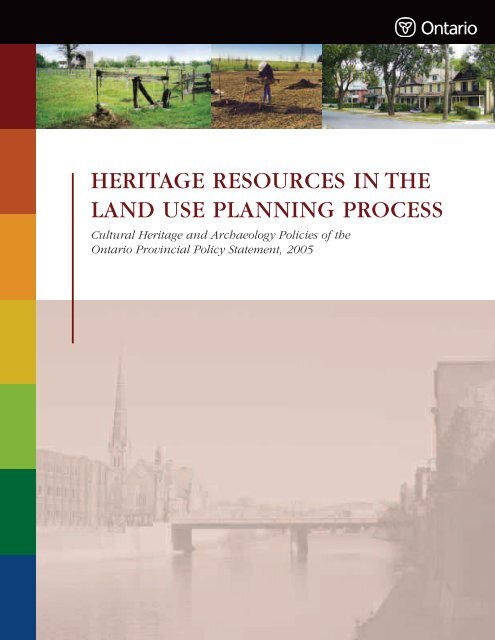
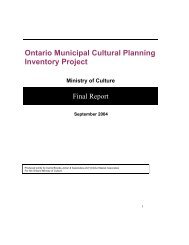
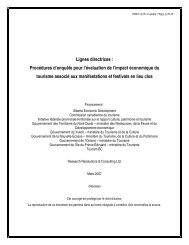
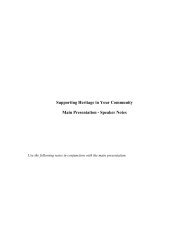
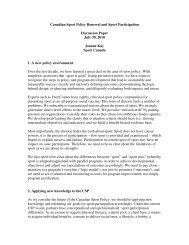
![THIS AGREEMENT made this [date], between [name of owner] (the ...](https://img.yumpu.com/49827605/1/158x260/this-agreement-made-this-date-between-name-of-owner-the-.jpg?quality=85)

